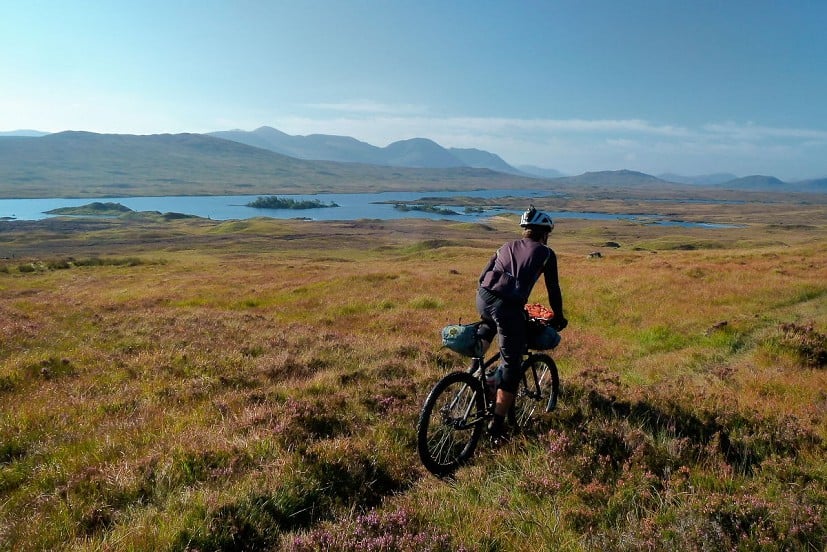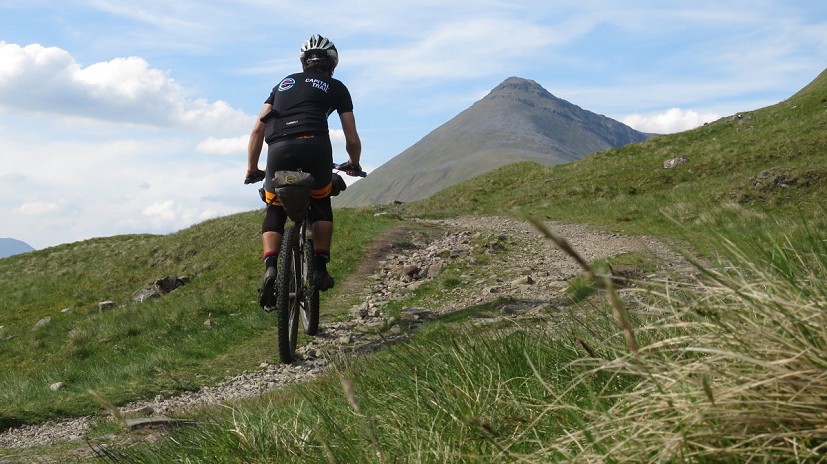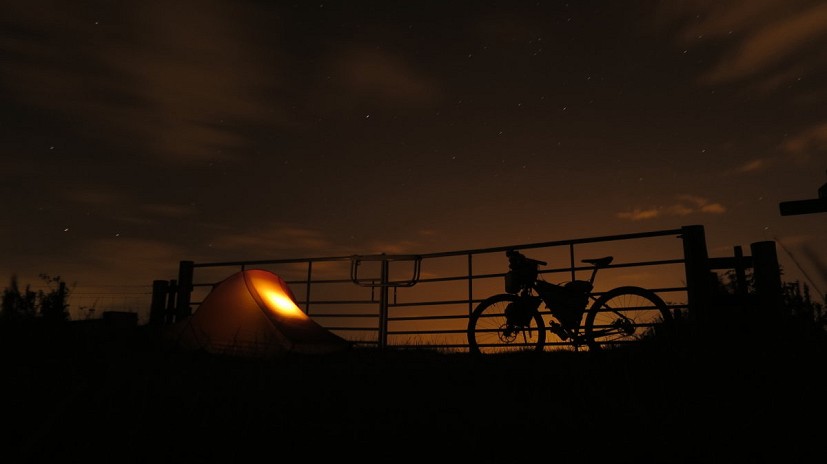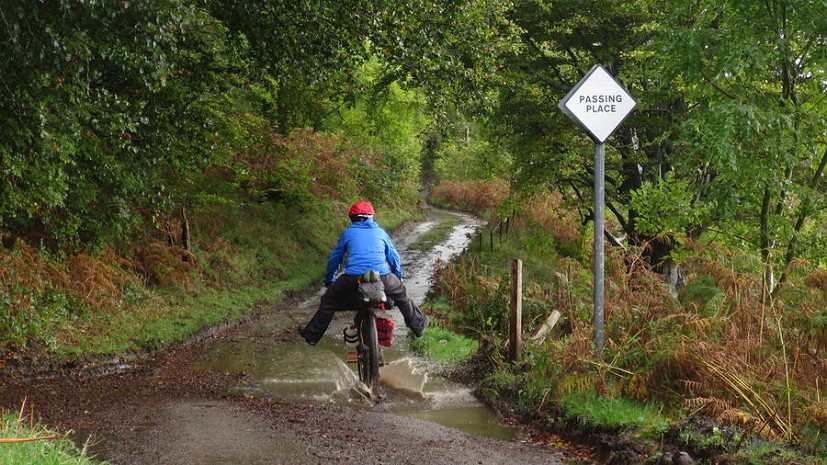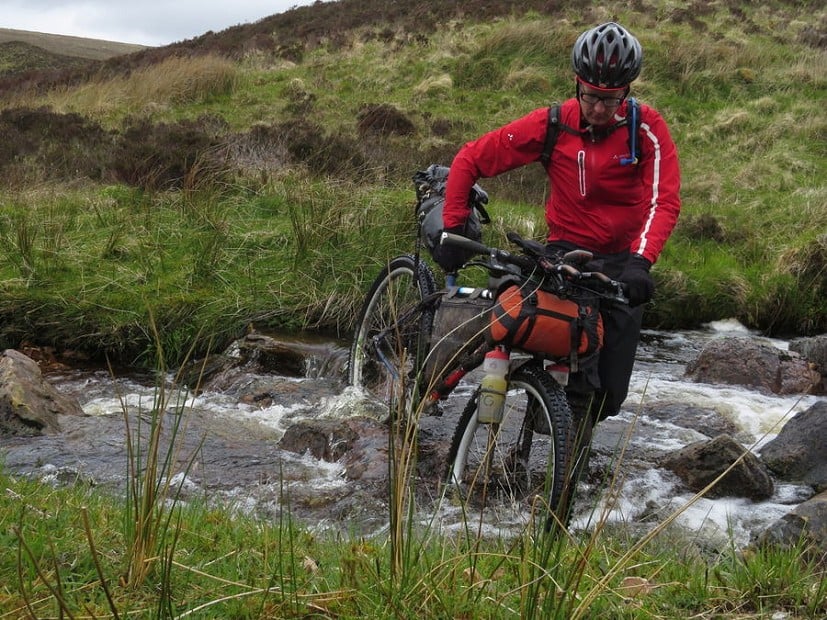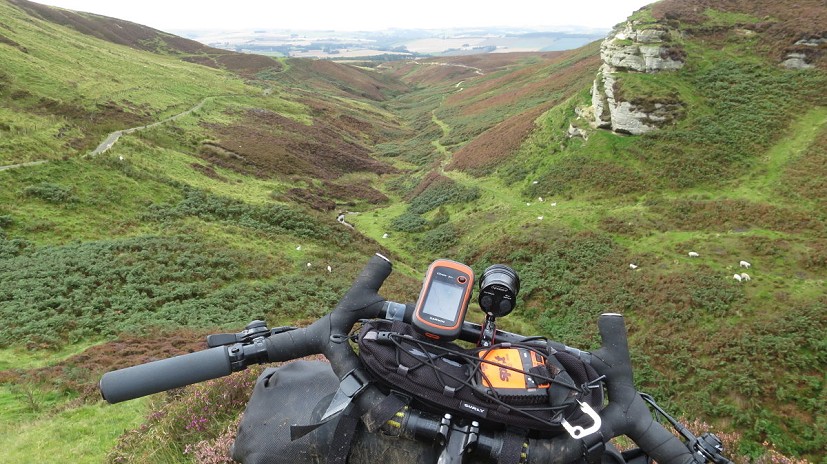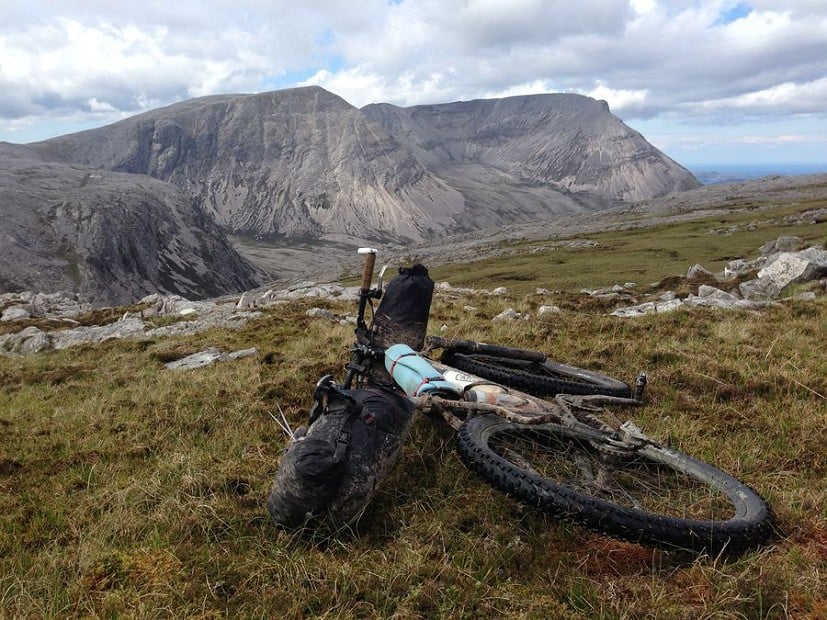Bikepacking - A Beginner's Intro
At the crossroads between cycle touring, mountain biking and backpacking, the emerging bikepacking scene is fast gaining traction. To keen walkers, the idea of taking off with a bike and a tent may seem attractive, allowing you to cover more ground than on foot, while still escaping civilisation. Whether it's combined with walking some summits, or an alternative activity in its own right, just think of all those hundreds of kilometres of farm, hill and forest tracks and the possibilities seem vast. But what exactly is bikepacking; what gear will you need; and how should you make a start? Markus Stitz, one of the UK's leading bikepacking exponents, shares some advice for beginners.
When you're out and about in the hills you might have seen people riding in unlikely places, on bikes festooned with bags. These people are bikepacking, an activity that has become popular in recent years. Simply speaking this is a form of bike touring that can take you far off the road. Using lightweight bags strapped directly to the frame, instead of racks and panniers, the weight can to be distributed much better, which enables people to ride further, faster and lighter, on ground that a traditional road tourer would not dare to dream about. Think minimalist backpacking with a bike, but minus a heavy rucksack.
If there's one country made for bikepacking, then it's Scotland. While the weather can at times provide a serious challenge, the access rights, scenery, an abundance of fresh water and a network of historic routes make Scotland a paradise for this, still relatively new, form of adventure cycling. While some of those Roman roads, drove roads, pilgrimage routes, miners' paths, trading paths, military roads, turnpike roads and shieling paths are often to long or too boring to walk, they provide for a proper adventure on two wheels.
But before you go, here is some useful advice to get started.
Which bike?
The biggest question at the beginning. What is the best bike for bikepacking? It's also the toughest question to answer, as personal preference is the major deciding factor here. As all bikes are suited in some shape or form for riding on tarmac, focussing on different off-road bikes suitable for bikepacking makes most sense here.
Mountain bikes have come a long way since they surfaced onto the market in the eighties, and are the most versatile choice to discover the backcountry. Reliability is the key criteria for any bike used for bikepacking, one of the reasons why rigid steel bikes have risen in popularity in recent years again. For mountain bikes there are three different wheel sizes available: 26'', 27.5'' and 29''. While still used on fatbikes and entry level bikes, 26 inch-wheels are hard to find on new bikes these days for good reasons. Both 27.5 inch and 29 inch-wheels roll much better over tricky terrain and come in normal and plus sizes, which take the tyre width up to 3 inches. While suspension adds a lot of comfort to the journey, it can also end it immediately if things go wrong, and finding spare parts in remote regions is most likely Mission Impossible. Using bigger tires and setting them up tubeless allows for much lower tire pressure, so suspension is not necessarily needed for comfort and handling, and a carbon fork can smoothen the rigid ride experience even more.
While most bikes still come with flat or riser bars, there are two handlebar models that are particularly suited for bikepacking. Jones H-Bars and Surly's Moloko Bar are swept back by 45 and 34 degrees and may look unconventional, but they provide added space to mount bags, GPS unit, camera and lights. They offer a multitude of hand positions to keep you comfortable and in control over the course of a long day riding over varied terrain. Some rigid bike forks come with two or four sets of bosses, offering the opportunity to add cages on the fork to carry additional bags.
Gravel bikes are the most recent addition to bikepacking, suited for less technical trails and long expeditions. Usually equipped with drop bars and 700C wheels they combine lighter weight with the ability to ride off-road, and are well-suited for trails that feature a good amount of roads and gravel or forest tracks.
Disc brakes are key to the success of every bikepacking adventure. Mechanical disc brakes lack the power and precision of their hydraulic counterparts, but replacing a cable is much easier than bleeding a hydraulic hose. If you don't mind adjusting your brakes manually, they are recommended. 1x drivetrains have become popular in recent years, reducing the things that might go wrong further by eliminating the need for a front derailleur; those are now commonly used on gravel and mountain bikes alike, but the ultimate choice for bikepacking is still an internal hub like the Rohloff Speedhub. A dynamo hub on the front is a welcome addition to charge battery packs or power lights during riding.
Why bikepacking bags?
Bikepacking as an activity is hard to define, since the differences from traditional touring are often blurred. Traditionally, multi-day cycling expeditions have required the use of a rack and panniers, an approach that adds considerable weight and mechanical complexity to the cycling experience. With recent innovations in textile construction rackless packing systems have taken over, and most commonly bikepacking involves those systems. The bags reduce not only the mechanical complexity and weight considerably, they also allow for much greater flexibility when choosing a bike. Most modern aluminium and carbon bikes don't come with additional mounts any longer, since bikepacking bags allow for carrying gear without the need for racks.
Waterproof or not? Just like the bike question, this is a tricky one to answer. While there are a few bags on the market that claim to be fully waterproof, a dry liner inside any bag offers not only waterproofness, it can easily be taken out and carried into the tent or room, leaving the muddy bags where they belong, on the bike. And on the rare occasion that your bike needs to be floated across a river they guarantee dry clothes, whereas waterproof bags have some form of ventilation built in, otherwise the contents would get mouldy very soon.
Bags can be mounted on saddle, handlebars, fork, frame and stem. The most crucial part on saddle bags are the buckles and straps, ensuring a proper fit. Handlebar bags come in various sizes to fit different bar shapes, and extensions are available from some manufacturers to store items that are needed throughout the day, like food and electronics. Stem bags, mounted with straps on either side of the stem, can be used as additional storage for food and bottles, but can also be mounted on saddle bags. The shape of the frame triangle and the use of rear suspension or not are crucial for choosing a frame bag, which can either fit over the whole space available in the triangle or only part of it, allowing for using bottle cages or to shoulder the bike. Using lightweight cages on the fork provides another opportunity to mount smaller bags or bottles; due to the good accessibility they are great to host tools, spares, food and cooking gear.
And while there's nothing wrong with backpacks in principle, especially for hydration systems, the additional weight on the back can be a real nuisance on longer trips, especially on bikes with drop bars. Drink bladders fit well in frame bags, and with the abundance of fresh water in the UK, often there isn't a need to carry large amounts, so two bottles mounted on frame or fork will normally do.
How to pack?
There's one basic principle to stick to when it comes to bikepacking, and that is to take less. Room in the bags is limited, and with multi-day trips at times requiring to use the spare room to carry enough food, it is wise to master the art of reducing the kit down to what is really necessary.
What to pack also depends on the type of bikepacking trip that is planned. Spending the night away from civilisation in the hills requires to take at least a bivvy bag, mattress and sleeping bag. A tarp can provide much needed shelter, however an ultra light tent also provides protection from midges and other uninvited guests.
In general, an item's packed size matters more than its weight when it comes to packing your bags. Down sleeping bags and an inflatable mattress can both be condensed down to the size of a small water bottle, the lightest tents on the market don't take up much more room than a big water bottle, and even when a trip doesn't involve camping from the outset, it is wise to carry this kit. At times it is difficult to estimate how long a section of the route takes, so carrying basic overnight equipment is highly recommended for every trip. A down jacket is an item that should be on every packing list, as it provides not only comfort on nights out, it can also help in emergencies. A waterproof shell is a sensible item for each expedition as well.
Lighter items like clothing and sleeping bag are better packed into the saddle bag, while heavier or bulky items fit better in the handlebar bag. Tools, items that are needed during the ride and food are best packed into frame bags. Bags have different closing systems, but larger items that might be needed during the day should be packed into the handlebar bag. To prevent the saddle bag from swaying around it needs to be properly packed and compressed, so taking items out during the ride is not advised.
Safety kit
Most hillwalkers and backpackers choose not to use them, but with phone signals often patchy in remote regions, a Spot Gen 3 satellite tracker is arguably a sensible safety device for bikepacking. With one-way messaging, the satellite tracker lets family and friends know you're OK or sends emergency responders your GPS location, all at the push of a button. There are different tracking packages and an additional search and rescue package, which allows for helicopter rescue in almost all corners of the world.
If you rely on phone alone, registering your phone with the emergencySMS service is a wise precaution, best achieved before you actually need it. Send the word register to 999, you will then receive SMS messages about the service and when you have read these SMS messages, reply by sending 'yes' in an SMS message to 999.
A first aid kit is a must, while an emergency blanket, bivvy or bothy bag provide basic shelter when things go wrong. A good helmet and gloves, as well as suitable shoes should be on the top of each packing list for a bikepacking adventure.
Books and useful websites
Scottish Hill Tracks is a brilliant resource for finding new bikepacking routes. Divided into 24 sections it features the network of paths, old roads and rights of way which criss-cross Scotland's hill country, from the Borders to Caithness.
The Heritage Paths Website (www.heritagepaths.co.uk) features old routes that are often suitable for bikepacking like Roman roads, Drove roads, Pilgrimage routes, Miners' paths, Trading paths, Military roads, Turnpike roads and Shieling paths. The website offers maps as well, using Google Maps street map overlaid with 1930s mapping by Bartholomew and Ordnance Survey.
Bikepacking Scotland (www.bikepackingscotland.com) features a number of bikepacking routes in Scotland, while Bikepacking.com (www.bikepacking.com) covers most of the world. Both are great resources for inspiration and to download GPX files.
The Scottish Bothy Bible is another good source of inspiration, bothies are a great alternative to camping wild and allow to carry less gear. While author Geoff Allan is a fond believer in the additional storage space that pannier bags provide for Thai food and red wine, bikepacking and the use of rackless systems improves the handling of a bike significantly, and allows for most bothies to be reached by bike.
Scotland Mountain Biking: Wild Trails Vol.1 and Vol.2 are two more good resources to get inspiration for the first bikepacking trip. Both books feature classic mountain bike routes in Scotland, which can often be combined for a bigger adventure.
Longer bikepacking trips in Scotland
Wild About Argyll Trail
Argyll and the Isles, Scotland's Adventure Coast, provides an awe-inspiring setting for bikepacking. At 407 miles this is a long-distance trail that is suitable for gravel and mountain bikes alike. It features long-distance hiking routes like the Three Lochs Way, Cowal Way and Kintyre Way alongside sections of popular cycling routes like the Caledonia Way and West Loch Lomond Cycle Way. More information can be found at www.bikepackingscotland.com/argyll
Highland Trail 550
This is a classic bikepacking trail, which is annually tackled by about 60 riders from across the world. Starting and finishing in Tyndrum it requires good walking skills at times, while the river crossing near Shenavall bothy can add a few days to the adventure. For great views and to experience the remoteness of the Scottish Highlands this is the perfect loop, at 560 miles and with loads of climbing added it requires above average fitness and bike handling skills. More information can be found at www.highlandtrail.net
Central Belter
At 750 miles the Central Belter is the toughest and most diverse route in Scotland. While it is a great expedition by itself, it also connects the Capital Trail, Reiver Raid, Highland Trail 550, Cairngorms Loop and Deeside Trail. While riding all those trails in one go would be beyond epic, the Central Belter itself requires very good legs to be completed. More information can be found at www.bikepackingscotland.com/centralbelter
Shorter bikepacking trips in Scotland
Capital Trail
The Capital Trail is 155 mile route starting and finishing on Portobello Beach in Edinburgh, ideal for a long weekend expedition around Edinburgh, the Lothians and the Scottish Borders. Well-known hillwalking routes like the Gypsy Glen, the Three Brethren and sections of the Southern Upland and Borders Abbeys Ways are part of the Capital Trail, while its real attraction lies in the many small and hidden paths in between the better known routes. More information can be found at www.bikepackingscotland.com/capitaltrail
Reiver Raid
If you are new to bikepacking the Reiver Raid is a great introduction. Starting and finishing at Tweedbank Station it crosses the beautiful Ale Water Valley in the Scottish Borders on tracks, paths and quiet roads, while it also offers good places to stop and enjoy the local food. At 108 miles it is a great weekend adventure. More information can be found at www.bikepackingscotland.com/reiverraid
About Markus Stitz
Markus Stitz is the founder of Bikepacking Scotland, through which he works with local partners to create new bikepacking routes in Scotland. An avid adventurer and cyclist, but also a keen walker, Markus' longest bikepacking journey took almost a year to complete, circumnavigating the world on a singlespeed bike from September 2015 to August 2016. His first creation, the Capital Trail, was awarded as 'Best New Trail' in 2015 by bikepacking.com. He writes for magazines, speaks about his adventures and is a keen photographer. More about him and Bikepacking Scotland can be found here:
